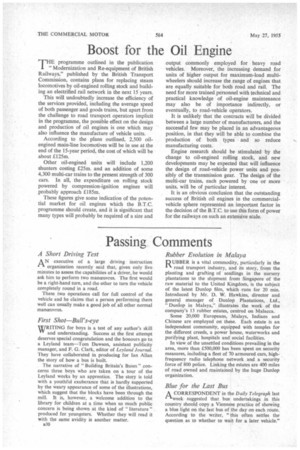Boost for the Oil Engine
Page 38

If you've noticed an error in this article please click here to report it so we can fix it.
THE programme outlined in the publication "Modernization and Re-equipment of British Railways," published by the British Transport Commission, contains plans for replacing steam locomotives by oil-engined rolling stock and building an electrified rail network in the next 15 years.
This will undoubtedly increase the efficiency of the services provided, including the average speed of both passenger and goods trains, but apart from the challenge to road transport operators implicit in the programme, the possible effect on the design and production of oil engines is one which may also influence the manufacture of vehicle units.
According to the plans outlined, 2,500 oilengined main-line locomotives will be in use at the end of the 15-year period, the cost of which will be about £125m.
Other oil-engined units will include 1,200 shunters costing £25m. and an addition of some 4,300 multi-car trains to the present strength of 300 cars. In all, the expenditure on rolling stock powered by compression-ignition engines will probably approach 185m.
These figures give some indication of the potential market for oil engines which the B.T.C. programme should create, and it is significant that many types will probably be required of a size and output commonly employed for heavy road vehicles. Moreover, the increasing demand for units of higher output for maximum-load multiwheelers should increase the range of engines that are equally suitable for both road and rail. The need for more trained personnel with technical and practical knowledge of oil-engine maintenance may also be of importance indirectly, or eventually, to road-vehicle operators.
It is unlikely that the contracts will be divided between a large number of manufacturers, and the successful few may be placed in an advantageous position, in that they will be able to combine the production of both types and so reduce manufacturing costs.
Engine research should be stimulated by the change to oil-engined rolling stock, and new developments may be expected that will influence the design of road-vehicle power units and possibly of the transmission gear. The design of the multi-car trains, each powered by one or more units, will be of particular interest.
It is an obvious conclusion that the outstanding success of British oil engines in the commercialvehicle sphere represented an important factor in the decision of the B.T.C. to use this form of power for the railways on such an extensive scale.








































































































